Welcome to the last few days of January, we are rapidly heading towards those lighter nights and mornings now, I hope, for I do not like dark nights when I can only sit and think, rather than sit and work.
There are a few things going on behind the scenes which we will bring you in due course. But for now settle back and hopefully enjoy....
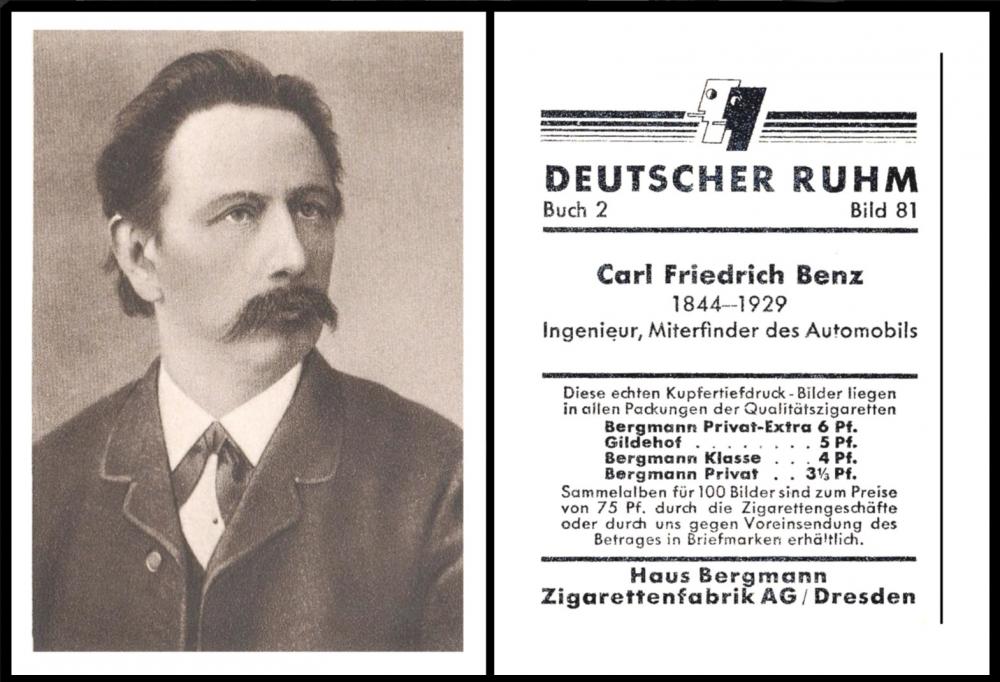
On this day in 1886 a German designer and engineer patented the first proper automobile. There had been other designs for cars, but they all had some kind of flaw that would lead to them not being produced in any form or in any number. By this time he already had a company, Carl Friedrich Benz, of Mannheim, which would become the worlds largest automobile factory.
This was quite a rise in fortune for the Benz family, who had not been rich. Carl had been born in 1844, to a locomotive driver and a local girl, the two were not married and she used her own name for his surname on the birth certificate. The couple married a few months after the birth, but the marriage only lasted two years before the husband was dead, of pneumonia. After that the son`s surname was changed to Benz, that of his father. They had little money but Carl went regularly to school and moved over to one with science as its major, then to a polytechnic. After school he found work in engineering companies and in a bicycle repair shop. This was where he had the germ of his idea to make the spokes and wheels for his vehicle out of metal rather than wood.
His first reliable petrol two-stroke engine was tested in December 1879 and patented in 1880. This was followed by designs for a speed regulation system, a battery and coil ignition system, a carburettor with spark plugs, a clutch and gear shift mechanism, and a water radiator for cooling. Putting these together, and making a stronger four-stroke engine, soon led to the Benz Patent-Motorwagen of 1885, patented on 29 January 1886, as an “automobile powered by gas”, and, after a few modifications, sold to the general public from 1888, a date which makes it the earliest car to be sold in such a way.
It only had two gears t that time, the third only being added after a long distance testing trip of over a hundred miles suggested one might be necessary, and that some kind of brake lining might also be of use. This trip was made by Mrs Benz and two of her children, some say without her husband`s knowledge, but that seems doubtful as even if he did not miss them, he surely would have wondered where his car had gone.
Other automobilia firsts followed for Carl Benz, in 1894 the first large scale production car known as the Velo[cipede], as well as the factory`s entry in the first ever automobile race from Paris to Rouen - in 1895 the first motorised bus, which until then had been horse drawn, and the first motorised truck - and by 1899 his was the largest automobile manufactory in the world.
In 1926 it merged with another European maker, Daimler, to make Daimler-Benz, though their cars were called Mercedes-Benz. Karl Benz died three years later aged 84.
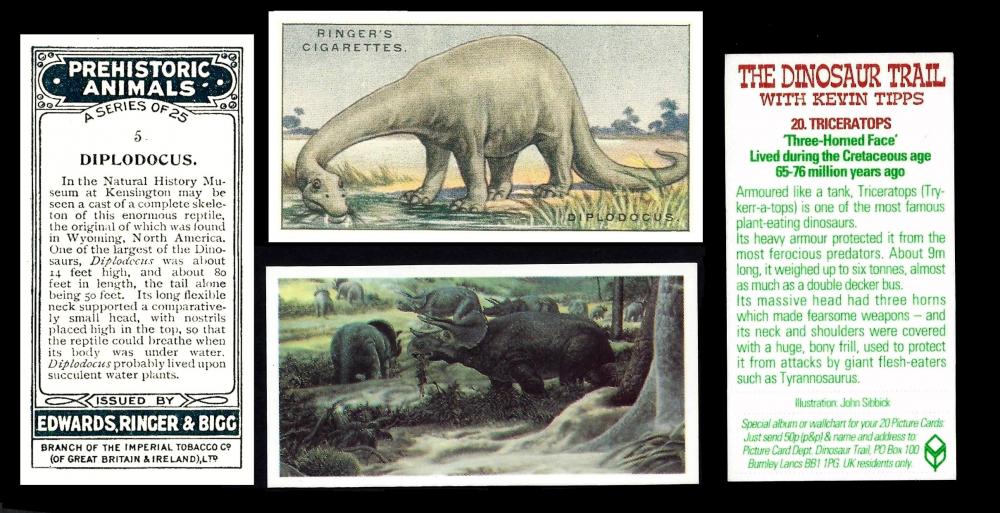
Today is National Draw A Dinosaur Day, so why not?
Ever since the dinosaur was discovered children have been fascinated by these giant creatures, and their art works will be posted all over social media, however there is nothing to stop any of us having a go as well, it matters not how good you are, only that you get enjoyment and pleasure out of what you do.
As for how the day started, well it was with a doodle, by a student, on this day, and much like threading a needle, everyone watching was soon itching to have a go.
Now as you might imagine, these “terrible lizards” are much featured on cards, especially trade cards. You can see a super collection of dinosaur trade card images courtesy of the London Cigarette Card Company website - do have a look and see how many you remember collecting – for my part that is the Brooke Bonds, the Walls Magicards, and the Kelloggs 3D cards.
However dinosaurs were also issued with cigarette cards, check out our first card above, Edwards Ringer Bigg “Prehistoric Animals”(1924) a set of 25 - and Cavanders “Peeps into Prehistoric Times” which spread over several series. And for more, I now pass you over to the master of everything to do with the dinosaur kingdom and that is a collector`s website called dinofan - where you will find almost three thousand sets and almost a hundred and twenty five thousand items all featuring dinosaurs.
If that still does not inspire you to draw one, then how about “Gertie”, the first ever cartoon dinosaur, from 1914. And you can read about her at the International Movie Data Base
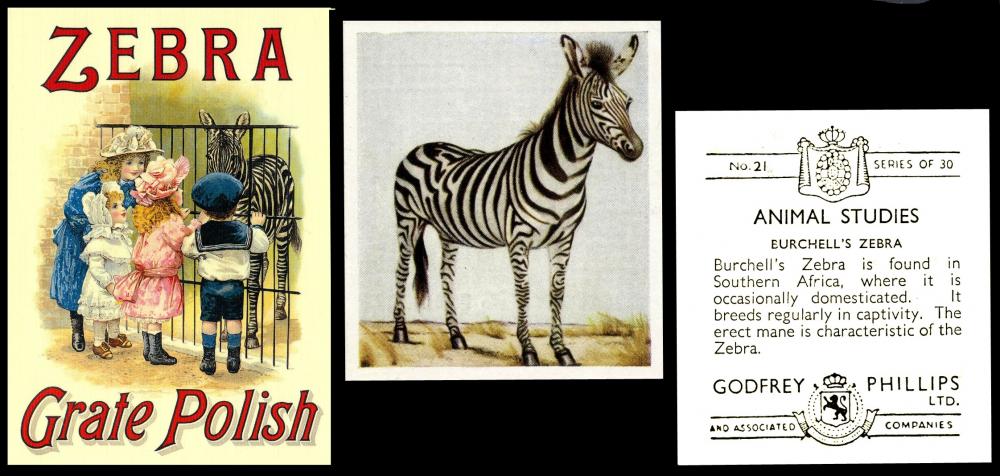
International Zebra Day - A day for awareness of the conservation issues of Zebras. And you can see several cards at the New York Public Library
This strange creature is actually related to the horse but they are supposed to be way less amenable to being trained as for riding and driving. However there is proof that this can be done, check out Vintage News You will also find a carriage pulled by a zebra on some advertising for Zebra Grate and Stove Polish, produced by Reckitt and Sons, and also Mazawattee Tea had a team of zebras pulling some of their vehicles, in fact they celebrate this with their current logo, at the head of their website.
Now another mystery is how the zebra got their stripes; it is said that it was to blend in with grasslands, but how did he make them come? Some of us may feel that is proof of other beings in this universe, and an ever guiding hand, but science has other ideas, and you can read what is probably the more logical, if not so exciting truth at New Scientist
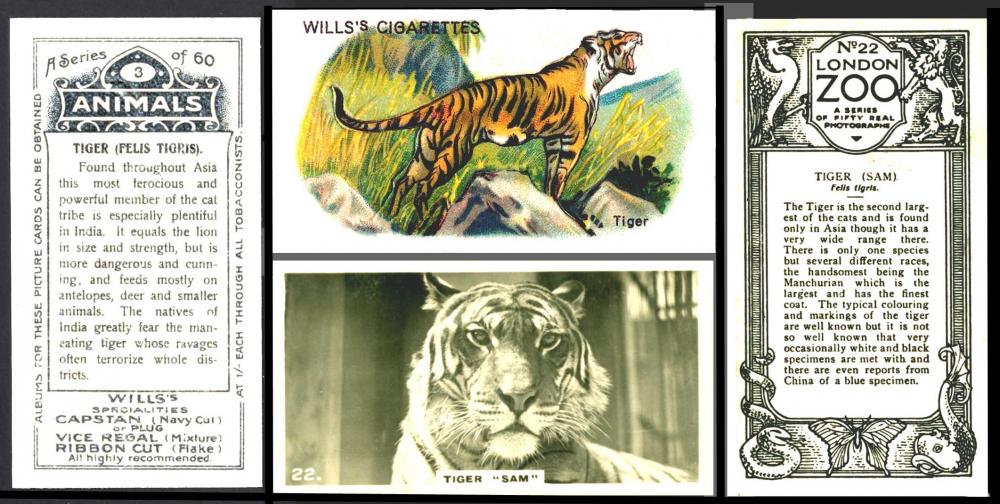
According to the Chinese Calendar, today we say goodbye to the patient Ox and welcome the year of the Tiger; this year it is a water tiger, which slightly "waters" down the fact that to the Chinese, tigers are exciting, strong, and attractive, with a whimsicality that sees them sometimes doing of unexpected things. And it is supposed to be a lucky sign.
You are probably a tiger if you were born in 1938, 1950, 1962, 1974, 1986, 1998, or 2010, but the starting dates vary from our calendar year so do consult the internet to make sure.
I am actually a rabbit (and I doubt any of you will be very surprised by that!)
Tigers appear on quite a lot of cards, but I will pass swiftly over any that show of it killing other creatures or of us killing it. That narrows the field a bit as mankind is not too kind to animals now, but was even worse in the heyday of the vintage cigarette card. However there are a few really attractive ones, two of which are by Allen and Ginter, Tiger, from the Wild Animals of the World series (N25) 1888 shows a super head study, and the Quadrupeds series (N21) 1890 shows a snarling tiger in a natural background. This latter picture is also available on their larger sized version where the small card is inserted as a card on top of a foliate backdrop.
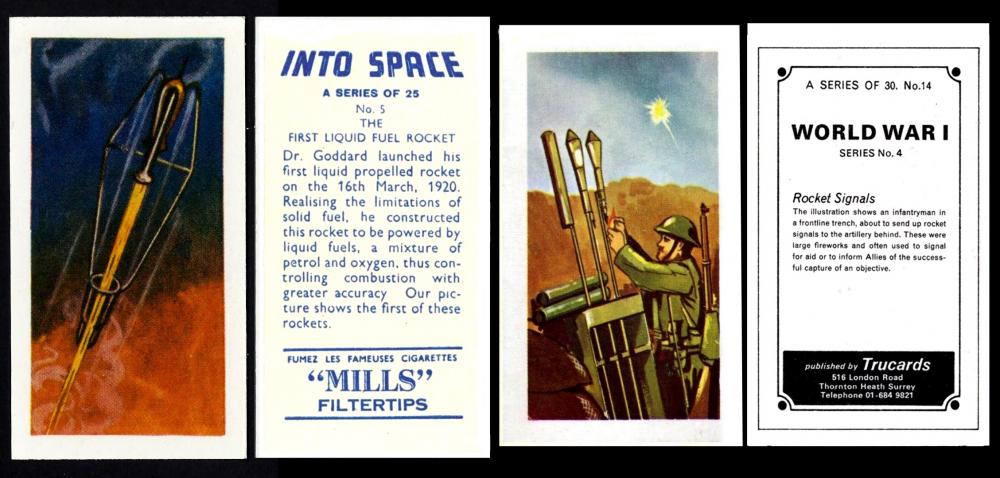
This is quite intriguing, for today in 1931 saw an intriguing experiment, when items of mail were first delivered by a rocket.
This took place in Austria, and after a few tries it became a regular service, each rocket containing up to three hundred letters which were sent upwards from the home base of to a site in Graz. Once the mail landed there it was removed from the container, (a risky business as it was made of asbestos inside and out), sorted and then sent on by standard post, but each item also carried a special rocket mail stamp. It is stated that not a letter was ever lost.
The idea was supposed to have come from a signalling system used in the trenches during the First World War, but the inventor of rocket mail is said to be Friedrich Schmiedl, an Austrian, born in 1902, who would probably have been too young to have been in the First World War. However, he did study in Graz and his experiments into solid fuelled rocketry supposedly started in 1918, possibly as a school project, which makes some sense, as rocketry was actively promoted by Germany because, like gliders, they were not banned under the terms of the Cessation of Hostilities, so it could well have been promoted in schools and colleges because in there were the future fliers and rocket scientists that it was already believed would be needed should a Second War break out. Now Schmiedl experimented at Schöckl which was 15 km north of Graz, and on February 2nd he launched a rocket with mail which it flew for 3km, guided by remote control.
Another candidate for the first rocket mailer could have been Reinhold Tiling, but his first successful mailing was on 15 April, 1931, in Germany. There is an interesting webpage about Tiling and his follower at post and parcel - however it does not explain the cause of his death, so to save you wondering, it was through rocketry, actually through an explosion in his workshop, which also killed his female assistant and a mechanic.
His follower, Gerhard Zucker is commemorated with on the postal museum website which shows examples of mail
Rocket mail was a good idea but it had a big problem in that it was not financed by the Post Office but by private individuals, and was seen as direct competition. Also in 1935 the private ownership of explosives was disallowed. There was a brief flurry of interest in rocket mail again, or in rocketry, when the first stirrings of conflict emerged in the late 1930s but Schmiedl was opposed to this, to the point that he destroyed his work.
In the mid 1930s more experiments were made in India
Our first card shows the first liquid fuel rocket, from “Into Space” issued by Amalgamated Tobacco Corporation, with “Mills” brand cigarettes. The set was also issued as trade cards by Swettenham and by A.S. Wilkinson Confectionery of Newcastle Upon Tyne, whose cards advertise “Cremona Toffee”.
Our second shows rocketry in the First World War, signalling by use of devices, this is a Trucards issue
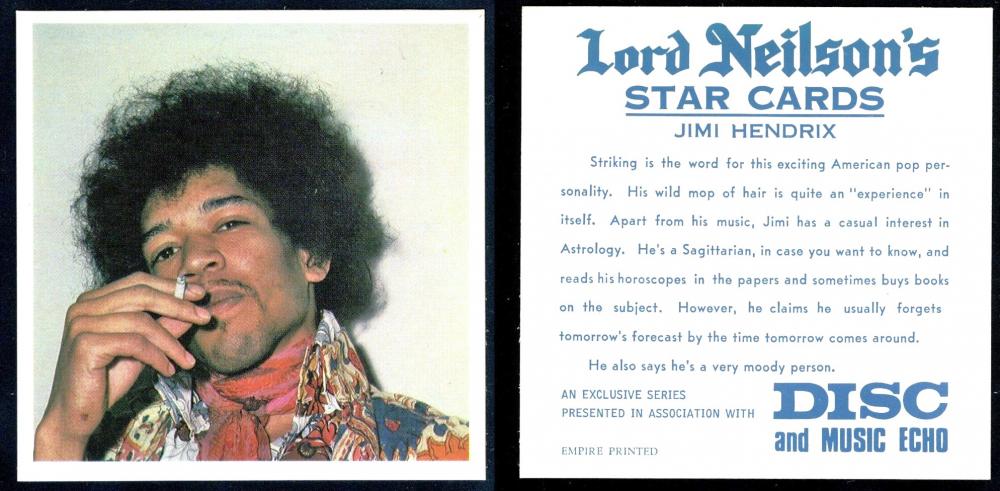
Well here we are at the end of the 1960s, and in a “Purple Haze", which was recorded on this day by Johnny Allen Hendrix, who at the time of recording was going under the name of James Marshall "Jimi" Hendrix.
He had been born in Seattle in November 1942, and started picking a guitar aged just 15. Ten years on, here he is making what many think is his greatest ever record. (Though I would go for “All Along The Watchtower”).
Who knows what wonderful music he may have made if he had not just lived for a few more years. However in those short years he did enough to see him cited as one of the best electric guitarists ever, and in the words of The Rock and Roll Hall of Fame, “arguably the greatest instrumentalist in the history of rock", despite only one album, “Electric Ladyland, reaching number one on the hit parade, and most of his awards and recognition coming after his death.
He was also the world`s highest paid performer, and perhaps that surfeit of money served to indirectly cause his death, aged just twenty-seven, from barbiturate-related asphyxia on September 18, 1970.
The Trading Card Database has him on thirty nine cards, mostly after his death again. However there is one that was issued whilst he was alive, and that is the one we show above - it is “Star Cards” from 1968. Though this says it was issued by "Lord Neilsons", that former rival company had actually been part of Lyons since 1962. Another card not mentioned on that database is Lyons Maid "Pop Scene" (1971)
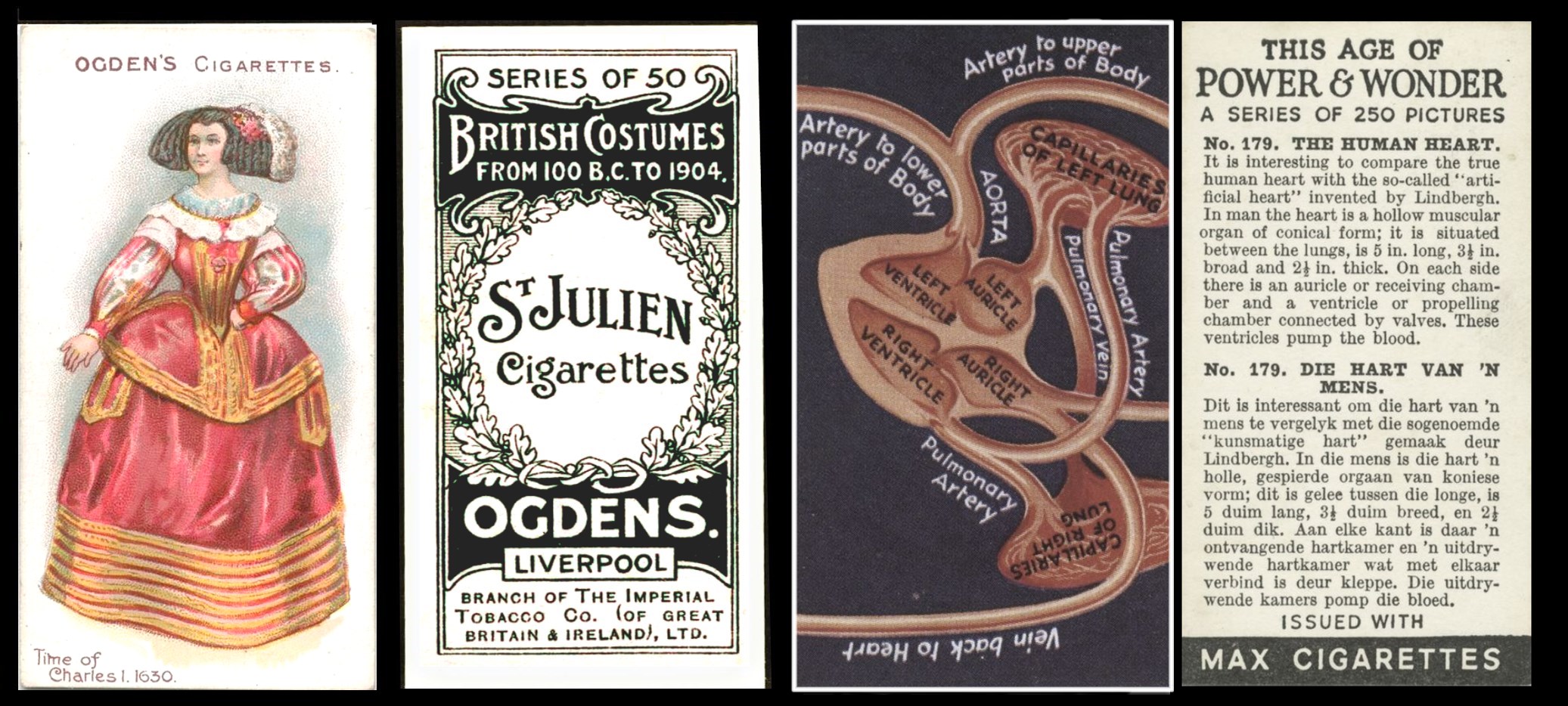
today, the first Friday in February, for all you twitterers, it is #WearRedDay - and the start of American Heart Month. . This is more an American event, but why, as it marks the sad fact that heart disease and stroke is very much a silent assassin; however by shouting about it more people will get tested and less will suffer. And in the dark gloominess of February, wearing even a small bit of red will go a long way to brightening things up.
This week's Cards of the Day...
This week our “Cards of the Day” featured Desert Island Discs, the popular radio series, which celebrates its eightieth year this week, and all started with a simple idea by Mr. Roy Plomley, who wondered, idly, what records famous people would like to play on a desert island to amuse them. He wrote to the BBC and they also liked the idea. The first episode was recorded on the 27th of January 1942, eighty years ago this Thursday.
We, and hopefully you, reached "Desert Island Discs in the following manner...
Saturday, 22nd January 2022

Our first clue was a tricky one, but it was the name of the player, Sands, as in sands on the shore of the desert island.
Our subject, Percy R. Sands, played for Woolwich Arsenal. Cohen Weenen “Football Captains”. which covers the 1907-8 League division 1, has him as P.R. Sands, and has a descriptive back which tells us he was a Centre half-back but could also play full back.
He first played with Woolwich Arsenal as an amateur, and he seems quite a valuable player, probably why he was the Captain.
Now this is card is one of a massive set, of over 1400 cards, split into two main groups.
The first group is branded with either “Grapnel” Mixture or “Imperial” Tobacco backs, being further split by whether they have straight or decorative framelines on the reverse, and further still by whether or not below those are three lines of text relating to “Myrtle Grove”. These were issued from 1907 to 1909. However, until at least 1948 his card had only been found with a back design for “Grapnel" Mixture, which was described as "A delightfully cool pipe tobacco, combining the sweetness and fragrance of the better class Virginia Tobaccos with the rich flavour of Latakia....” ( Latakia was, and still is, a Syrian tobacco). However some time after that, his card was discovered with a back design for “Imperial Tobacco, A ripe, full flavoured pipe tobacco, fine cut...” -
The second group, ours, are all “London Mixture”, and they were issued from 1913 to 1914. The intention is believed to have been to issue a squad of fifteen players for each of the clubs, as had happened in the first groupings, but this was unfortunately halted by the First World War.
Our original Taddy reference book (RB.12, published in 1948, and originally costing 7/6d.) covers this set over eighteen pages, over half the volume size, and it also includes lists of all player and club cards known at that time. The original was a limited edition of four hundred books, and it is long out of print, but we do sell a reprint in our bookshop, which ought to be up and running again really soon. So watch this space! And an even more updated list of names appears in our British Tobacco Issues Handbook (RB.135, published in 2003).
Obviously reprinting all this in our original World Tobacco Issues Index was not practicable, so it is condensed into just over a page, listing the clubs alone. The number of cards known has also increased, to 1330 (I worked that out, do not rely on it). And by the time of our updated World Tobacco Issues Index, in the year 2000, the total had reached 1375.
Sunday, 23rd January 2022
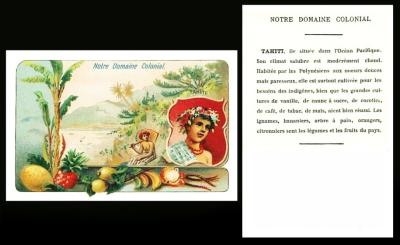
Our third clue was this super card of Tahiti and that ought to have given you the island in Desert Island Discs.
Tahiti is also most people`s idea of the perfect desert island. It is in the South Pacific, and it is the largest island in French Polynesia, plus there is a large indigenous population. The big surprise though is that the sand there is not white, nor yellow, it is black, a souvenir of when the volcanoes there were in full flow.
It is often said to have been discovered by Captain James Cook in the eighteenth century, but this is only the first western explorer to reach the shores. The very first feet to touch the shore were from neighbouring islands, and from South East Asia, a very long time before, it is thought prior to 500 BC, and they arrived by canoe, the menfolk coming first and then the families and their livestock. It must have been an amazing journey, and would have involved repeated trips, to and from the same location, without the benefits of today`s SatNavs and computers.
However Tahiti`s real claim to fame came in the 1890s, when the French artist Eugene Henri Paul Gauguin moved there and immortalised the area in his works. He even married a local girl. However it was not the idyll he thought it would be, and though he would later send nine of the paintings to a Paris Art dealer, which were exhibited in Copenhagen, they did not meet with much acclaim from the gallery visitors, and few were sold.
I have simplified the English translation of the title of this set a bit, and also made it kinder, for "Domaine" actually means "lands under our control".
As here, this card is often found anonymous, but the large space at the bottom of the reverse has a reason, and that is to be overprinted with a trade advertisement. As I find these I will add them in
Monday, 24th January 2022
![KAN-070.1 : KAA-5 [trade : UK] Kane Products "Disc Stars" large size 94 m/m x 66 m/m (1959) 17/50](/sites/default/files/styles/content_aligned/public/2022-01/24%20kane.jpg?itok=hyg48kb5)
There were two reasons that we have this card here. The first is pretty obvious, the name of the set, which is "Disc Stars" for Desert Island Discs. However our featured singers, The Beverley Sisters, did appear on the show, on Monday the 16th of January 1961. They chose as a group, and you can see what they chose at BBCRadio4/DID-Bev61 - and it is a very eclectic mixture. Look closely at the books chosen, for one of the authors, Billy Wright, was actually married to Joy Beverley.
This set was originally listed in our British Trade Index part two. Also note that KAA-4 was a medium sized set 62 m/m x 60 m/m; this set has the address "London W.2" whilst our set is "East Grinstead". A special album was issued for the first series.
Kane Products made confectionery, particularly sweet cigarettes – one of their most interesting dates from 1957, this packet shows Roy Rogers and his horse Trigger, and they must have had some cash because the bottom of the reverse of that packet says “AUTHORISED BY ROY ROGERS. SOLD UNDER LICENSE” - the reverse also contains an image of a Sheriff`s Deputy badge, which could be cut out and worn, probably why packets are not so easy to come by.
According to another packet of “Navy Cut Sweet Cigarettes” that is currently for sale on eBay, their London address was Leghorn Road, N.W.10, that is in Kensal Rise, and the distributor was C.B.T. Ltd of London W2; whilst their East Grinstead address was London Road. Neither of these premises seem to exist today.
Tuesday, 25th January 2022
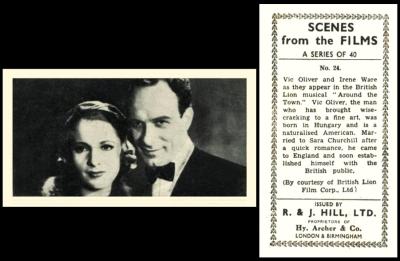
This card shows Vic Oliver, and he was the first person to appear on Desert Island Discs. His original name was Victor Oliver von Samek, and he was born in Austria in 1898, the son of a Baron. He planned to be a doctor but fell in love with music, at one stage being taught by Gustav Mahler. He fought in a cavalry regiment during the First World War, and rumour has it a fellow soldier in his squad was Adolf Hitler. I cant find any truth to this, and Adolf Hitler served in the 16th Reserve Division of the Bavarian Army from 1914 -1920 and not the Austro Hungarian Army.
After the war Vic Oliver did several jobs before music came back into his life.By the late 1920s he was a conductor, violinist and comedian, appearing in variety and revues. Though he was an excellent violinist he played it badly for comedic effect. He also appeared in several films in the late 1930s and early 1940s, which is how he came to appear on our card. Eventually he would form the Vic Oliver Concert Orchestra and “Variety Playhouse”, a very popular radio show in magazine style with lots of different segments, possibly the forerunner of many of today`s television shows.
In 1936 he married Winston Churchill`s daughter, and she is mentioned on this card though it is not immediately clear that it is so, she is simply called Sara Churchill, with no reference to her parentage. Perhaps this is because the marriage met with parental disapproval, for many reasons - not just because she was the third Mrs Oliver. This may have been for good reason, because the couple divorced in 1945, and there was a fourth Mrs. Oliver the following year.
One thing you may not realise is that this edition of Desert Island Discs was before it was on mainstream radio - it was broadcast on 29 January 1942 over The BBC Forces Programme, a national radio station, intended to entertain soldiers waiting to go to war, and broadcast over regional stations near to barracks and encampments, however civilians started tuning in it, and it soon became more popular than the Home Service. However it only operated from January 1940 until February 1944 and though it was replaced by the General Forces Programme which was slightly altered in order to appeal to overseas troops as well, that too closed in 1946.
This set first appears in our reference book to the issues of R. & J. Hill, (RB.2, published in 1942), as :
40. SCENES FROM THE FILMS (titled series). Size 2 1/2" x 1 7/16". Numbered 1-40. Fronts, printed in black only from half-tone blocks - black and white - with white margins but no subject titles.Backs, printed in black, with descriptions and inscribed "Issued by R. & J. Hill, Ltd., Proprietors of Hy. Archer & Co." (See Henry Archer & Co.). Printed by W. Oliver, London.
This booklet did not have card codes, they were only thought of later on.
By the time of our original World Tobacco Index, the set is described as :
SCENES FROM THE FILMS. Sm. 64 x 36. Black and White. Nd. (40) ... H46-94.
The same text appears in our updated World Tobacco Issues Index but the code is different.
Wednesday, 26th January 2022
![[trade : OS] T. Presser & Co (USA) “Famous Composers” (1910?) Un/? Handel](/sites/default/files/styles/content_aligned/public/2022-01/26%20handel.jpg?itok=-5p2_-pV)
This card is because Handel`s work “The Messiah” is the most requested music on Desert Island, with 119 the castaways choosing it, though they do not always choose the same section of the music.
Thanks to the collector who supplied this card, but wishes to remain anonymous. He also wrote us this short piece about the cards, which I am sure you will enjoy...
This is just one of the cards that were published by “T. Presser Phila”, or Theodore Presser, whose company is the oldest music publishers in the United States of America, founded in 1883, and still going strong, as well as still being based in Philadelphia, currently in Malvern.
Until 2004 it was still very much a family business, but then it was acquired by Carl Fischer.
Theodore Presser himself was born in 1848, and his first job was at an iron foundry, as just a teenager, when he found himself called on to join in the secondary occupation of the works, which was making cannonballs for the American Civil War. However this did not work out, so he left, one theory is that the work was very heavy and he started to suffer with ill health.
Instead of this he got a part time job selling tickets for a local opera company, and this led to him finding employment at a music store, where he worked his way up to becoming the sheet music manager.. Along the way, he decided he would like to get better educated in music, and eventually he started publishing his own magazine on musical topics, as well as the production of sheet music.
These cards may not have been issued by him at all, because it only has him as a publisher. We also do not know how they were issued, there is a thought that they might have been sold commercially, but as they are all printed with “Reward Card” it is thought that they most probably had something to do with teaching, or with attendance at music schools.
There is also some doubt as to the title because the cards are untitled; however every card shows the birthplace of the composer, and also a facsimile of their signature so perhaps those provides a clue to the real title. This card is the most interesting because the front name is Haendel, with an extra “E” but the reverse does not repeat that spelling and goes for the more normal Handel. He did spell his name with that extra “E” from time to time so the thought is that this illustration of him had that version of his name as a title and so it was just copied off by the artist who made the drawing for the card.
Another unusual card shows Cecile Chaminade, though sometimes this appears in listings as “Cecil” but she was a lady composer, one of Queen Victoria`s favourites. And she is so far the only lady composer in the set.
I have made a list of all those known so far – it seems to have stuck at thirty four, which seems an odd number, so anyone knowing of any others, please do let me know.
-
Johann Sebastian Bach
-
Bartholdy
-
Ludwig Van Beethoven
-
Georges Bizet
-
J. Brahms
-
Cecile Chaminade
-
Frederic Francois Chopin
-
Claude Debussy
-
Antonin Dvorak
-
Edward Elgar
-
Christoph W. Von Gluck
-
Charles Gounod
-
Edward Grieg
-
George Frederic Handel
-
Josef Haydn
-
Franz Liszt
-
Edward MacDowell
-
Jules Massenet
-
Felix Mendelssohn
-
Maurice Moszkowski
-
Modest Moussorgsky
-
Wolfgang Amadeus Mozart
-
Anton Rubinstein
-
Nicolas Rimsky-Korsakow
-
Gioacchino Rossini
-
Anton Rubinstein
-
Camille Saint-Saens
-
Franz Schubert
-
Robert Schumann
-
Jean Sibelius
-
P.J. Tschaikowsky
-
Guiseppe Verdi
-
Richard Wagner
-
C.M. V Weber;
Thursday, 27th January 2022
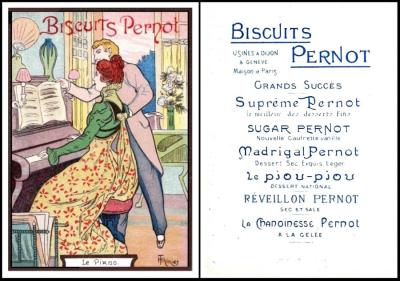
It may surprise you but a piano is the most requested musical instrument on "Desert Island Discs" - even by The Beverley Sisters. However it is not very easy to carry, and would probably not function too well as a life raft in its present state. Mind you, perhaps the wood could be dismantled carefully and then be reconstructed as a more suitable craft with which to set to sail.
The only thing I can say in its favour is that as it is quite hard to learn to play the piano, and it can be quite dis"chord"ant, so doing so on a far off desert island will at least not disturb your neighbours! And I have to say that if I had to be marooned on a desert island with a piano a "player" piano would be a far better choice as I could close my eyes and convince myself that someone else was there with me, tinkling away.
By the way, the second most requested instrument was a guitar, which is much more to my liking.
Now this card is one of many that were issued by Pernot, a company founded in 1869, by Auguste Pernot, in Dijon, an area of France much more known for mustard than for biscuits, so it is perhaps not surprising that at first the factory also produced mustard. Then, in 1883, it was bought by two brothers, Lucien and Georges Richard, who were not so keen on the mustard, but loved the biscuits, and it was under their ownership that the international reputation of Pernot Biscuits really took off.
However after the Second World War they never really recovered and though the company was bought out in the mid 1960s in less than a decade all production ceased.
Today the factory is used for housing.
We know that this card was printed by [Carlos Joseph] Courmont, who was a lithographic printer, based in Paris, who was founded about 1876, and we know that this card must have been issued after 1896 because in that year he was joined by his brother Emile and they changed the name of the company to Courmont Freres (or the Courmont Brothers), which is what it says right at the bottom of the reverse. They had a huge output, including postcards and posters, and had a contract with the railways as well. Yet somehow they closed down in 1902.
As for the design of this card, well that was by Henri Thiriet, who was obviously a very talented artist, and yet has left almost no trail of who he was. All I have found is that he was born in 1873 and died in 1946.
We are also uncertain as to how many cards comprised the set, and whether there were not two sets, one showing a definite Medieval style (listed as (M) below) and some, like ours, which are more Victorian or Edwardian. Anyway we have tracked down the following :
- Clarrinet
- Guitarre
- Harp (M)
- Harp Gothique (M)
- Luth (M)
- Piano
- Theorbo (M)
- Vielle et Tambour
- Viola d`Amour (M)
maybe you can add some as well?
Friday, 28th January 2022

This is a nod to an oft quoted possible mistake of "Desert Island Discs" for the theme tune "By the Sleepy Lagoon" by Eric Coates contains bird noises. However, these birds are herring gulls — and many listeners have seen fit to point out with some indignity that herring gulls would not have been on a tropical island at all, so either the birds are wrong, or the "desert island" is simply a walk away from a bustling seaside town.
and there we must close for another week. See you all next month...
